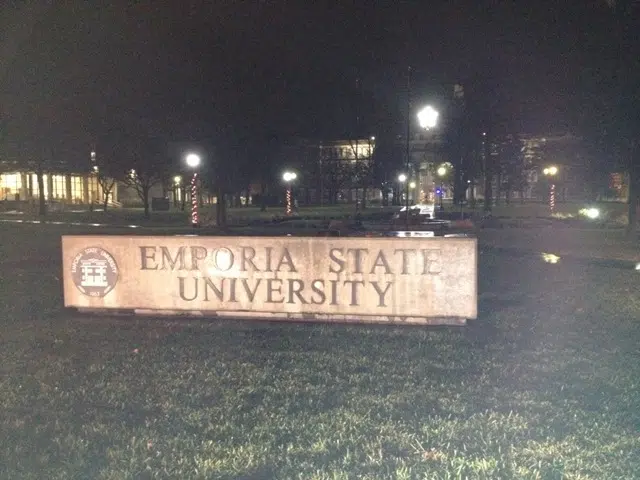Back in October, the American Association of University Professors said it would investigate staff cuts at Emporia State following the Kansas Board of Regents’ approval of ESU’s Framework for Workforce Management.
The report is out. And it blasts both ESU and the Board of Regents for the approved plan, which it says was based in part on “shifting and incoherent rationales.”
The 16-page report begins with basic background information about Emporia State, followed by “events of concern” — starting with the Board of Regents’ temporary policy allowing universities to end positions due to COVID-related financial pressures and continuing through Emporia State’s dismissals of over 30 faculty and staff, most of them tenured professors.
AAUP’s involvement started because of concerns the ESU policy was against AAUP standards, initially with the appeal process but later extending to academic freedom and its relationship with tenure status. AAUP says ESU President Ken Hush wrote a letter to the organization in October stating academic freedin, due process safeguards and the tenure tradition “are as valuable now as they have always been to our institution,” but AAUP sharply disagreed, saying the ESU administation hever had a “clear and consistent rationale” for terminating appointments other than saying no appointment was terminated for cause. The AAUP report also says ESU linked its actions to “extreme financial pressures” but said the university is not facing financial exigency, the higher education equivalent of potential bankruptcy.
The report concludes by castigating both university administration and the Board of Regents, saying “if we take them at their word, they are unfit to lead, least of all during a crisis,” saying the terminations — initiated by the Regents’ COVID-based personnel policy — were a “direct assault” on tenure and academic freedom and a violation of the Regents’ financial duties. It also says the lack of “meaningful faculty involvement” in developing Emporia State’s plan of action shows “deficient” conditions for shared governance.
Following the report’s release, ESU announced a short statement: “Emporia State University does not agree with the report published by AAUP. ESU is committed to moving forward with strategic reinvestments that deliver elevated, best-in-class programs to today’s students and will ultimately benefit Kansas families and the Kansas workforce.”
KVOE News has reached out to AAUP for additional comment.
Academic Freedom and Tenure: Emporia State University (Kansas)
This report concerns the action taken on September 15, 2022, by the administration of Emporia State University to terminate the appointments of thirty tenured and tenure-track faculty members under a temporary “COVID-related workforce management policy” adopted by the Kansas Board of Regents (KBOR) in January 2021.1
I. The Institution
Emporia State University is a public four-year institution located in Emporia, Kansas. Founded in 1863 as the Kansas State Normal School, it is one of six state universities governed by KBOR. Emporia State currently enrolls roughly 5,600 students, some 3,000 of whom are undergraduates. There are about 230 full-time faculty members.2 Mr. Ken Hush, an alumnus, was named the university’s eighteenth president on June 22, 2022, after having served as interim president since November 17, 2021. Previously, Mr. Hush was chief executive officer of BLI Rentals, a rent-to-own storage barn and shed company, and held several executive positions at Koch Minerals and Carbon. Emporia State’s provost, Dr. R. Brent Thomas, former dean of the College of Liberal Arts and Sciences, served as dean and interim provost during the events recounted in this report. The chair of KBOR’s nine-member board is Mr. Jon Rolph, the president and chief executive officer of a large restaurant ownership group. Dr. Blake Flanders is the board’s president and chief executive officer, a staff position.
Eight faculty members at ESU sought the AAUP’s advice and assistance after receiving termination notices: Professors Douglas Allen, Michael Behrens, Rob Catlett, Dan Colson, Sheryl Lidzy, Christopher Lovett, Max McCoy, and Mel Storm.3 Professors Behrens, Colson, McCoy, and Storm held appointments in the Department of English, Modern Languages, and Journalism. Professor Behrens began his career at ESU in 2014, Professor Colson in 2012, Professor McCoy in 2006, and Professor Storm in 1971. Professor Catlett, a member of the Department of Mathematics and Economics, accepted his first appointment at ESU in 1976; Professor Lidzy, of the Department of Communication and Theater, in 2006; Professor Lovett, of the Department of Social Sciences, Sociology, and Criminology, in 1996; and Professor Allen, also of the Department of Social Sciences, Sociology, and Criminology, in 2019. Except for Professor Allen, whose appointment was probationary for tenure, all these faculty members held tenured appointments.
II. Events of Concern
At its January 20, 2021, meeting, the Kansas Board of Regents enacted “temporary pandemic-related amendments to the suspensions, terminations, and dismissals policy” to address “the extreme financial pressures placed on the state universities due to the COVID-19 pandemic, decreased program and university enrollments, and the state’s declining fiscal support.”4 The resulting new policy, which amended section II.C.6.b.ii of existing board policy, provided that “any state university employee, including a tenured faculty member, may be suspended, dismissed, or terminated from employment by their respective university. . . . Declaration of financial exigency shall not be a prerequisite to any suspension, dismissal, or termination authorized by this provision, and no existing university policy hearing procedures shall apply to such decisions.”
The policy was set to expire on December 31, 2022. In the meantime, its provisions could be implemented on a particular campus only if that institution’s president proposed “a framework for the university’s decision-making” to the board and the board approved it. Once approved, that framework would “be used for any suspension, dismissal, or termination . . . based on factors such as, but not limited to, performance evaluations, teaching and research productivity, low service productivity, low enrollment, cost of operations, or reduction in revenues for specific departments or schools.”
Only one president made such a request—almost two years after the policy’s adoption and three months before its expiration. On September 14, 2022, President Hush solicited and received board approval for Emporia State’s “Framework for Workforce Management.”5
According to that document, which echoes the board policy, Emporia State had “experienced extreme financial pressures accelerated by the COVID-19 pandemic, decreased program and university enrollment, and state fiscal issues” and continued “to face increases in the cost of operations across campus as well as substantive changes in the educational marketplace.” The rationale concludes, “While the University is not facing financial exigency, the financial and market situations do require a prudent review and restructuring, which will require modification, reorganization, suspension, or elimination of certain operations, programs and curriculum, which may require immediate action notwithstanding any other Board or institutional policy. This framework allows for a more orderly transition to what is best for the University.”
ESU’s framework provides that a decision to suspend, dismiss, or terminate any university employee shall be based on factors such as, but not limited to:
Low enrollment.
Cost of operations.
Reduction in revenues for specific departments or schools.
Current or future market considerations as to the need for a program or department.
Restructuring of a program, department, or school as determined to be necessary by the university.
Realignment of resources.
Performance evaluations.
Teaching and research productivity.
Low service productivity.
The document concludes by detailing the “procedure to be followed for taking action,” which is an abridged version of the procedure set out in the board policy.
The day after KBOR approved the framework, ESU faculty members began receiving termination notices. On September 15 all of the affected faculty members received a telephone call from the ESU administration directing them to attend a meeting within the hour at the Earl Center, an off-campus building that the university had been seeking to sell since November 2021. An email confirmation of each meeting closed as follows: “NOTE: Please do not arrive at your appointment more than 5 minutes early. As this is an individual meeting, no one should accompany you to the meeting.”
One faculty member described what happened upon arriving for his appointment:
“At the center, which is a for-sale, disused building in poor repair, we were met by campus police in the parking lot. After the door was unlocked, we were led into various rooms where we were informed of our termination by a pair of individuals, typically one administrator and one HR employee. Each session lasted about twenty minutes, and few questions were answered about our dismissals. The administrator . . . read aloud our dismissal letters as though we were being formally charged with a crime. We were then given a packet with the letter and other information and escorted down a hallway to a door that exited the opposite side of the building.”
The virtually identical notice letters, dated September 15 and signed by President Hush, advised faculty members of the terminations of their appointments effective May 16, 2023.6 The stated bases (again, echoing the board policy) were “extreme financial pressures accelerated by the COVID-19 pandemic, decreased program and university enrollment, continuing and ongoing increases in the cost of operations across campus, and substantive changes in the educational marketplace.” None of the letters explained why individual positions were selected for termination. Instead, they listed the same nine “factors” enumerated in the framework.
Each letter offered three months of severance pay, adding, “The university reserves the right to place you on paid administrative leave through your end date should the university determine that to be in the best interest of the university.” Some letters contained the following offer: “You may be eligible to retire from the university in lieu of being laid off. If you choose to retire, you will still receive three (3) months [of] severance pay.”
Regarding the basis for the action, the letters stated that the decision to terminate the appointments was made “under Kansas Board of Regents (Board) policy Chapter II, Section C., Paragraph 6.b., and in accordance with the required framework approved by the Board.” If faculty members wished to contest the termination of their appointments, the letters noted, they could appeal “through the Board of Regents office to the Office of Administrative Hearings,” adding that, in that process, the faculty member would carry the burden of proof.
III. The Association’s Involvement
On Wednesday, September 7, 2022, the ESU faculty senate received a draft of the framework document. The next day a faculty member emailed the AAUP’s staff requesting comment, explaining that the administration had requested that any faculty feedback be submitted by 10:00 a.m. on Monday, September 12. By email message of September 9, a staff member advised the faculty member, among other things, that
the proposed procedure outlined in the draft “Framework for Workforce Management” appears to be sharply at odds with [AAUP-recommended] standards in the following significant respects:
the faculty has no role at all, as the only parties that appear to be involved in the procedure are the “affected employee,” the university president, the governing board, and the Office of Administrative Hearings; the burden of proof is on the faculty member rather than on the administration; any appeal by a faculty member is to be made “through the Board of Regents Office to the Office of Administrative Hearings,” and “the decision of the administrative hearing officer is final and not subject to further administrative review by any officer or committee of the university or by the Board of Regents.”
The AAUP’s staff heard nothing further until September 16, when faculty members who had received termination notices began contacting the AAUP for assistance. The staff wrote to Chair Rolph and President Hush on September 27 to convey the Association’s position that the notices of termination violated key provisions of the joint 1940 Statement of Principles on Academic Freedom and Tenure (while noting that section 1B.07 of Emporia State’s University Policy Manual calls those provisions “reasonable and prudent”) as well as Regulation 4c of the AAUP’s Recommended Institutional Regulations on Academic Freedom and Tenure, which governs the termination of appointments on grounds of financial exigency.After explicating those provisions, the letter concluded, “Absent countervailing information, the AAUP is compelled to regard the administration’s actions that resulted in the termination of tenured appointments as having been taken without a legitimate basis.”
The letter separately addressed the case of Professor Allen, the only complainant whose appointment was probationary for tenure, citing the applicable AAUP-supported standards, those set out in in Regulation 2 of the Recommended Institutional Regulations, noting that, under that regulation, “a tenure-track faculty member notified of nonrenewal must be afforded a written statement of the reasons for the decision; adequate notice (in Professor Allen’s case, twelve months); and the opportunity to contest the decision with an elected faculty body. The most evident departure from Regulation 2,” the letter continued, “is the failure to afford Professor Allen the latter opportunity. Under the framework, affected faculty members have thirty days to file an appeal through the board of regents, the very body ultimately responsible for the adverse decisions.”
The staff’s letter also cited allegations made by some complainants that the administration had singled them out because they had been “outspokenly critical of the administration and governing board.” The letter noted that if criticism of institutional authorities was indeed the reason for a decision to terminate faculty appointments, it violated academic freedom.
After strongly urging the immediate rescission of the termination notices, the staff’s letter reiterated the Association’s concerns:
We must emphasize that tenure is inseparable from the due-process protections, such as those set forth in Regulation 4c(3), that define it. As the Framework omits such protections, it effectively eliminates tenure and, by extension, academic freedom. In combination with the curious fact that, reportedly, many if not most of the university employees whose services were terminated were tenured faculty members, it is difficult not to construe what has happened at Emporia State as a direct assault on tenure and academic freedom, with grave implications for tenure and academic freedom not only at Emporia State but throughout the Kansas system of public higher education.
The letter closed by informing President Hush that the Association’s senior professional staff and executive director would be meeting on October 11 to discuss the staff’s recommendation that an ad hoc committee be appointed to investigate the cases.
President Hush replied at length on October 10, responding to what he characterized as the staff’s “hypothesis . . . that certain faculty were laid off for reasons related to their exercise of academic freedom and were denied due process, and that these lay-offs signify a threat to tenure at Emporia State University.” He asserted, “We assure you that academic freedom, the safeguard[s] of due process, and the tradition of tenure are as valuable now as they have always been to our institution, and the abrogation or abandonment of those principles played no part whatsoever in any of the decisions made, or processes followed, regarding the lay-off of any ESU employee on September 15, 2022.”
In the rest of the letter, President Hush outlined the process by which the administration arrived at the framework: “Seeking to find ways to relieve the university of its ongoing deficits and . . . to reinvigorate the university for long-term success,” the administration began developing a “Strategic Enrollment Management Plan” in July 2021. The administration asked department chairs to provide feedback on a draft of the plan in February 2022; the “entire campus” was asked to do the same in April. The final plan identified “five primary areas of focus: (1) Credit and non-credit offerings and delivery of instructions; (2) University identity + image; (3) Recruitment + admission of students; (4) Student success + graduation; and (5) Financial sustainability.”
“With the impending financial and operational crisis in mind,” President Hush continued, “I formed a new Leadership Team of approximately twenty-five persons who represented key voices throughout our campus community” and subsequently “a specific team of twelve individuals, selected for their contributions to the university and their representation of leadership across campus.” The task of the latter group was “to evaluate, question, and consider the operational, financial, and marketplace value of all academic programs.”
President Hush addressed the AAUP’s concerns about potential violations of academic freedom. “I unequivocally state that no personnel decision was made at any time based on any person’s personal, professional, or political views, expressions, or statements.” In support of this assertion, the president quoted the testimony of a tenured professor of history who had written, “The idea that the professors who were terminated due to their outspokenness and criticism of the administration does not hold water.” After describing himself as an active scholar, a “popular” teacher, and a responsible member of the university community, the professor noted that he was “also a political conservative” who has been “quite active and quite vocal in expressing [his] views.” Nevertheless, “here I am, an example of how ESU promotes both academic freedom and tenure. I was never denied either, nor was I ever pressured to rescind or to not speak out or to not engage in my outside interests as a conservative.” In fact, “My career has blossomed at ESU, and in 2021 I was appointed the [university’s] government relations officer for my knowledge of and connections with key political figures in the state of Kansas.”7
In closing, President Hush expressed confidence that the AAUP’s staff would “recognize the alignment in what we’ve done, and what we are doing, with AAUP’s own vision of higher education’s ultimate purpose.”
On October 12, the staff wrote to inform President Hush that the AAUP’s executive director had authorized an investigation of the affected faculty members’ cases and that a formal response to his letter of October 10 was forthcoming. That response, dated October 14, stated that the process that the president had described as leading to the adoption of the Framework for Workforce Management “did not appear to comport with AAUP-supported procedures for terminating tenured appointments.” Moreover, the letter noted, the affected faculty members “sharply dispute your letter’s assertions regarding the extent to which Emporia State’s faculty was meaningfully involved in that process, the timeframe for the faculty to review and comment on the draft framework, and the reality of the university’s alleged ‘impending financial and operational crisis.’”
The staff’s letter also informed President Hush that his October 10 letter did “not address our primary concern that, in terminating the appointments of tenured faculty members for stated financial reasons, the Emporia State administration disregarded AAUPrecommended principles and standards on academic freedom and tenure.”
Replying on October 24, President Hush reiterated the main points of his previous letter, adding, “The grounds for each lay-off on September 15, 2022, were in alignment with, and pursuant to, the university’s Workforce Management Policy, which strictly followed the rationales permitted by the Kansas Board of Regents’ governing policy. Accordingly, the underlying reasoning and the use of the university’s Workforce Management Policy complies with, and conforms to, the motivation behind, and enactment of, the Kansas Board of Regents’ governing policy.”
The letter closed, “Because Emporia State University is actively involved in, and duly respects, the process and import of the administrative appeals filed by some of our directly affected faculty members, the University and its administration will not participate in AAUP’s investigation as you have described it.”
The staff wrote once more, on October 26, to announce the names of members of the ad hoc investigating committee and to urge President Hush to reconsider his decision not to participate, adding, “As the . . . termination notices are dated September 15, it appears from the timeline set forth in the Framework for Workforce Management that your and the Board of Regents’ respective roles in the appeal process will conclude by November 24. The investigating committee has therefore agreed to conduct its interviews by video conference in early December. In addition to interviewing the affected faculty members, including those who have not yet contacted us, the committee would like to schedule time to meet with you so that you may elaborate further on the administration’s position.” That letter received no response.
The undersigned investigating committee convened in November and conducted interviews by video conference in December and January. The committee interviewed fifteen current and former ESU faculty members, including many who had received notice of termination; Kansas AAUP conference leaders; a former interim president of ESU; and the current chair of KBOR. Additionally, the committee reviewed voluminous evidence related to the subject faculty members’ cases, including appeals documents and the administration’s responses, board and university policies, the minutes of KBOR and ESU faculty senate meetings, and local and national press accounts. In response to an invitation from the committee, President Hush wrote on December 19 to confirm that neither he nor any member of his administration would participate, once again citing the appeals process, which had continued far longer than the initial administrative timeline had indicated.8
IV. Issues of Association Concern
The investigating committee considers the following to be the most compelling issues posed by this case.
A. Procedural Issues
The actions against the thirty faculty members directly implicate AAUP-supported procedural standards.
1. Termination of Appointments for Financial Reasons
The AAUP recognizes only three legitimate bases for terminating a tenured faculty appointment: dismissal for cause, a bona fide financial exigency, and the “bona fide formal discontinuance of a program or department of instruction” for educational reasons. Since KBOR and the ESU administration cited “extreme financial pressures” as the basis for the terminations, Regulation 4c, “Financial Exigency,” of the AAUP’s Recommended Institutional Regulations on Academic Freedom and Tenure would appear to set forth the most relevant Association-supported procedural standards (section 3C.10, “Financial Exigency,” of the Emporia State policy manual incorporates the essential provisions of Regulation 4c). As previously noted, however, the board’s COVID-related workforce management policy explicitly states, “Declaration of financial exigency and the processes associated with a declaration of financial exigency shall not be a prerequisite to any suspension, dismissal, or termination authorized by this provision, and no existing university policy hearing procedures shall apply.” In compliance with the regents’ enabling policy, President Hush’s “Framework for Workforce Management” nullifies section 3C.10 along with any other university regulations that would have precluded arbitrary and unilateral program cuts and appointment terminations. As a result, the process by which the administration terminated the services of thirty tenured and tenure-track faculty members departs in almost every single respect from Regulation 4c:
no “elected faculty governance body” participated meaningfully in decisions regarding financial exigency or in the determination that “all feasible alternatives to termination of appointments have been pursued”; neither the faculty as a whole nor any representative faculty body was afforded “primary responsibility” for “determining where within the overall academic program termination of appointments” would occur or “the criteria for identifying the individuals whose appointments are to be terminated”; “the faculty or an appropriate faculty body” did not “have the opportunity to render an assessment in writing of the institution’s financial condition”; the administration did not take into account either tenure or length of service in selecting faculty appointments for termination; the administration declined to make any effort to find other suitable positions within the university for affected faculty members; affected faculty members did not receive notice or severance salary as prescribed in Regulation 8;9 and none of the affected faculty members were afforded the protections of academic due process required under Regulation 4c.
In his October 24, 2022, letter (cited above), President Hush defended his administration’s course of action: “The grounds for each lay-off on September 15, 2022, were in alignment with, and pursuant to, the university’s Workforce Management Policy, which strictly followed the rationales permitted by the Kansas Board of Regents’ governing policy. Accordingly, the underlying reasoning and the use of the university’s Workforce Management policy complies with, and conforms to, the motivation behind, and enactment of, the Kansas Board of Regents’ governing policy.” The letter went on to state that the regents’ and the president’s “responsibilities, obligations, and expectations are mandated by statute and regulation. They are not advisory and cannot be mitigated by, or disregarded because of, other principles or standards. I am confident [that AAUP Executive Director Julie] Schmid, yourself, the AAUP’s senior professional staff, and AAUP’s standing Committee A recognize and understand the primacy and authority of statutory law, legal and fiduciary duty, and the sanction of lawfully enacted policy.”
In other words, by enacting the ESU framework under KBOR’s emergency workforce management policy, President Hush enabled and implemented a process for terminating tenured appointments that abrogated the university’s own existing policy and flagrantly violated applicable AAUP-recommended procedural standards, thus rendering the terminations illegitimate with respect to those standards.
2. Academic Due Process
An essential component of Regulation 4c of the Recommended Institutional Regulations is a set of provisions (Regulation 4c[3]) that entitles faculty members whose appointments are terminated for financial reasons to a “full hearing before a faculty committee” that conforms in most respects with Regulation 5, “Dismissal Procedures,” of the Recommended Institutional Regulations. In such a hearing, the faculty member has the right to contest “the existence and extent of the condition” of the financial emergency, “the validity of the educational judgments and the criteria for identification for termination,” and the appropriateness of the criteria as “applied in the individual case,” with the burden of proof on all issues resting with the administration, unless a faculty committee has reached a decision on the question. By incorporating Regulation 5 into Regulation 4, the Association ensures that its recommended regulations on financial exigency integrate a crucial element—academic due process. The Association understands tenure to be an indefinite appointment terminable only through the type of procedure set out in Regulation 5, in which the case for terminating a faculty appointment is heard by a body of peers, with the burden of proof on the administration. This procedure (which the AAUP regards as academic due process) is therefore the sine qua non of tenure. From the Association’s perspective, tenured faculty members at colleges or universities that do not afford academic due process to postprobationary faculty members facing the termination of their appointments do not enjoy genuine tenured status, regardless of their appointing institution’s representations to the contrary. As long as the framework was in effect at Emporia State, neither did ESU’s tenured faculty members.
As this report has shown, the Emporia State administration afforded the thirty affected faculty members no procedural rights that even remotely approximated academic due process. The only procedural remedy available to them was an opportunity to file appeals with the state’s Office of Administrative Hearings. In these appeals, the burden of proof rested with them to convince an administrative hearing officer that the adverse actions were “substantially inconsistent” with the “Framework for Workforce Management,” “the result of unlawful bias or discrimination,” or “otherwise unreasonable, arbitrary or capricious”—extremely narrow grounds from which to mount a successful appeal. Procedurally, the affected faculty members therefore found themselves in a highly disadvantaged position.
In implementing this shockingly inadequate process, the ESU administration managed to add insult to injury. The affected faculty members received virtually identical termination notices on September 15. In place of any specific rationale for why their particular appointments had been selected for termination, the administration merely cut and pasted the nine “factors” from the framework document, most of which were reproduced verbatim from the board’s COVID-19 workforce management policy. Taken together, these criteria placed few limits on whom the administration could choose to dismiss, or for what reason it could do so. As the faculty senate executive committee (one member of which met with the investigating committee) stated in its September 12 critique of the draft framework, the “termination criteria are so general that they could be used to release any employee at ESU” (emphasis in original). The administration clearly saw itself as under no obligation to offer specifics, much less to develop its proposal in concert with the faculty. On the contrary, in the view of the investigating committee, the termination criteria appear to represent more of a display of unilateral administrative dominance than a good-faith rationale.
Declining to provide specific reasons also served a tactical purpose: not knowing the rationale for the action against them made it difficult, if not impossible, for the affected faculty members to know specifically what to address in their appeals. As Dr. Lynnette Sievert, professor of biological sciences, asked the investigating committee, “How do you write an appeal letter when you don’t know why you’re being fired?” In every case of which the committee is aware, the administration offered specific reasons for termination of an individual faculty member’s appointment, in the form of rebuttals, only after the faculty member submitted an appeal with the Office of Administrative Hearings. The administration took the KBOR policy’s express abrogation of the right to discovery and exploited it to the hilt.
In responding to their appeals, the administration, having offered no specific information regarding why individual faculty members received termination notices, proceeded to chastise faculty members for failing to intuit the precise reasons for their selection. For example, in its response to the appeal of Dr. Brenda Koerner, associate professor of biological sciences, the administration wrote, “Indeed, the brevity of the factors cited as the basis for President Hush’s decision does not mean those factors do not provide a plain and reasonable explanation for Dr. Koerner’s lay-off or that those reasons were not data-driven. Nor does the conciseness of those factors deny or otherwise curb Dr. Koerner’s ability to present a well-argued appeal; they are sufficiently specific for review and, as discussed above, are supported by an extensive body of information and data that is, or has been, publicly available and publicly discussed both within, and outside of, ESU.”
This response is breathtaking in its feigned incredulity at Professor Koerner’s failure to reverse engineer the administration’s reasoning from the mere existence of available data. In addition, the appeal process allowed the administration to invent reasons for a termination that differed from those the faculty member had identified in her appeal. This mockery of a process is what the Emporia State administration, in its correspondence with the AAUP, and Chair Rolph, in his interview with the investigating committee, approvingly cited as providing academic due process for faculty members.
In at least one case, the administration went so far as to misrepresent the content of a faculty member’s appeal. In its response to Professor Sievert’s submission, the administration wrote, “Dr. Sievert’s appeal actually recites several reasons that reinforce the legitimate and reasonable basis for President Hush’s decision, to-wit: ‘A large group of the biology majors is preparing for advanced study in a healthcare field. To meet their needs, I will need to be replaced with someone who can teach healthcare type classes[.]’” (emphasis and brackets in original). The excerpted passage from Professor Sievert’s appeal reads in full: “A large group of the biology majors is preparing for advanced study in a healthcare field. To meet their needs, I will need to be replaced with someone who can teach healthcare type classes, which I am fully capable of doing” (emphasis added). The administration omitted the crucial final clause of Professor Sievert’s sentence, which goes to the heart of the question of her fitness to remain in the biological sciences department. The typographical evidence (“[.]”) makes plain that the omission was no accident, further evidence that the appeal process was totally inappropriate for its alleged purpose. A procedure in which an administration apparently feels comfortable making material misrepresentations before the adjudicating state office makes a mockery of basic due-process rights, not to mention the academic due process required under Association-supported standards.10
B. Substantive Issues
The explanations that the ESU administration gave for its actions do not withstand scrutiny.
1. Shifting and Incoherent Rationales
At no point did the Emporia State administration provide a clear and consistent rationale for terminating appointments, apart from asserting that no appointment was terminated for cause. In its communications with the affected faculty members, the campus community, and the AAUP, the administration vacillated among a constellation of budget- and program-related explanations.
Even though it attributed its actions to “extreme financial pressures,” the administration did not declare financial exigency. Indeed, the “Framework for Workforce Management” explicitly states, “The university is not facing financial exigency.” In offering other financially related explanations, the framework provides little detail, and no financial or enrollment data. Instead, it describes a confluence of financial pressures—related to enrollment, state funding, and operating costs—that public colleges and universities have felt for some time. But the administration did not explain what differentiated Emporia State from the hundreds of other colleges and universities that have overcome similar challenges in the last three years without resorting to such extreme measures as summarily terminating the appointments of tenured faculty members.
In stating its case to the regents, the administration made a logical hash of the interrelations among the financial forces at work: “Because ESU has experienced extreme financial pressures accelerated by the COVID-19 pandemic, decreased program and university enrollment, and state fiscal issues, the University continues to face increases in the cost of operations across campus as well as substantive changes in the educational marketplace.” A moment’s reflection reveals this sentence to be nonsensical. Any revenue declines caused by the pandemic or by downward trends in enrollment and state support are independent of inflationary increases in operating costs. Despite the administration’s juxtaposition of the two sets of factors, the latter are not caused by the former. Nonetheless, the Emporia State administration asked the board of regents to entrust it with the authority to apply its market wisdom to make sweeping unilateral changes to the university. The regents obliged.
The administration’s rationale was further clouded by key administrators’ repeated public claims that the terminations were not a budget-cutting measure but a “strategic realignment.” In a September 22, 2022, interview with the Bulletin, ESU’s student newspaper, Dr. Joan Brewer, dean of the teachers college and, at the time, interim provost, said, “This isn’t a budget cut, although it appears that way right now, and I understand that. It’s really about a strategic realignment for Emporia State University.”11 That same week Dr. Thomas, the other interim provost, told Inside Higher Ed, “It may be understandable why people would just look at this as just a cutting exercise, but it is different than what we’ve done in the past.”12
In other words, while the administration pleaded financial hardship and warned of an impending crisis when submitting its framework for KBOR approval, its media messaging painted a different picture. While soft-pedaling budgetary motivations for the terminations, the administration consistently emphasized the programmatic reinvestments to come. We are thus squarely outside the realm of financial exigency and in the territory of program discontinuance for educational, not financial, reasons. In such a situation, the applicable AAUP-supported standards are those set out in Regulation 4d of the Recommended Institutional Regulations.
Under Regulation 4d, “Discontinuance of Program or Department for Educational Reasons,” a bona fide program discontinuance “will be based essentially upon educational considerations, as determined by the faculty as a whole or an appropriate committee thereof” (emphasis added). “Educational considerations” exclude “cyclical or temporary variations in enrollment”; instead, they “must reflect longrange judgments that the educational mission of the institution as a whole will be enhanced by the discontinuance” of a department or program. As the AAUP’s Role of the Faculty in Conditions of Financial Exigency insists, “Program closure is very much a matter of educational policy.” As a result, “the faculty should . . . be accorded an initial and decisive role in any deliberations over program closure and release of tenured faculty members” (emphasis in original). Regulation 4d therefore requires that decisions to close academic programs and terminate appointments arise from a collective faculty judgment that these sacrifices are necessary for the long-term benefit of the educational mission of the institution and not merely a short-term budgetary maneuver.
The remaining provisions of Regulation 4d are almost identical to those of Regulation 4c. Under Regulation 4d(2), “Faculty members in a program being considered for discontinuance will promptly be informed of this activity in writing and provided at least thirty days in which to respond to it.” Under Regulation 4d(3), “Before the administration issues notice of its intention to terminate an appointment” because of program discontinuance, “the institution will make every effort to place the faculty member in another suitable position,” including providing financial and other support for a reasonable period of retraining. This regulation also requires the administration to pay “severance salary equitably adjusted to the faculty member’s length of past and potential service,” which “may well exceed but not be less than” one year of salary for faculty members with indefinite tenure. Finally, under Regulation 4d(4), affected faculty members have the right to contest any relocation or termination in an adjudicative hearing of record before an elected faculty hearing committee. Contestable issues include the “institution’s failure to satisfy any of the conditions” of Regulation 4d. In such a hearing, the burden of proof rests with the administration on every issue except a faculty determination that a program should be discontinued, which “will be considered presumptively valid.” Section 4P of Emporia State’s policy manual sets out the university’s “Program Discontinuance Policy,” which, like its financial exigency policy, comports in most essential respects with AAUP-recommended standards, in this case Regulation 4d. But, once again, President Hush’s framework document, in compliance with the board’s temporary workforce management policy, nullified a perfectly acceptable set of existing procedures.
As a result, the administration’s actions were as much at odds with Regulation 4d as they were with Regulation 4c. President Hush’s appointed leadership team privately decided on a set of program changes without involving the faculty. The proposed changes were designed not to address any substantive educational issue but to shore up flagging undergraduate enrollment numbers, as the administration’s refrain of “strategic realignment” makes clear. Having chosen to make these program changes under the controlling authority of KBOR’s temporary workforce policy, the administration sidelined faculty governance bodies and deprived the affected faculty members of academic due process.
The administration’s appeal responses expose yet one more inconsistent—and impermissible—rationale for the terminations. In those responses, the administration repeatedly cited, as a reason for terminating their appointments, the affected faculty members’ supposed disciplinary unfitness for the new program array resulting from the so-called strategic realignment. The reference to professional unfitness, however, implies a basis for termination related to professional competence, thus contradicting the administration’s assertions that none of the terminations were for cause. Incidentally, the university’s dismissal-for-cause procedures, set out in section 1B.0906 of the university’s policy manual and nullified by the framework, are entirely consistent with AAUP-recommended standards.
Other administrative attempts at justifying the terminations were merely illogical. For example, the administration cited its decision to “suspend” the BA in English as a reason for dismissing Professor Behrens. But as Professor Behrens told the investigating committee, most of his students, as well as those of his dismissed colleagues, are enrolled in the BS program in English education, which will continue to exist—now without most of the tenured faculty members who have been teaching the program’s content courses.
Perhaps the most glaring example of the administration’s program-related illogic appears in the case of Professor Sievert. The administration’s stated rationale for terminating her appointment was its decision to eliminate the physiology concentration in the Department of Biological Sciences as part of the “realignment”: “Although mammalian and vertebrate/invertebrate physiologists can teach, and often teach, Human Anatomy and Physiology courses as a matter of necessity, the University’s realignment of its curriculum’s focus on human Physiology as a springboard into medical programs needs the quality and professional knowledge of a human physiologist. Professor Sievert is not a human physiologist.”13 Multiple interviewees with whom the investigating committee spoke found this explanation laughable. One noted that Professor Sievert had been teaching the human cadaver dissection course for fifteen years. As Professor Sievert herself put it to the investigating committee, “They say they want to bring in a human physiologist; actually, they’re getting rid of the only human physiologist they have.” The investigating committee notes that illegitimate assessments like these are precisely why Regulation 4d prescribes an essential role for the faculty in decisions about program discontinuance and any resulting terminations.
To summarize, the administration of Emporia State University offered a confusing mixture of financial and program-related explanations for its decision to terminate thirty faculty appointments. Far from attempting to focus on one related set of factors in order to develop a plausible rationale, the administration insisted on entangling them. In responding to Professor Sievert’s appeal, for example, the administration described a “critical interplay between revenue loss, low enrollment, expense reduction, and programmatic realignment.” While the investigating committee does not dispute that such connections exist, the fact of their interrelation does not constitute a legitimate basis for terminating tenured faculty appointments, nor does the administration’s unilateral “realignment” of the curriculum.
2. Weakness of the COVID-Related Rationale
It is worth briefly considering how Emporia State’s situation differs from that of institutions that underwent program closures and terminations during the early height of the pandemic. As the AAUP’s Special Report: COVID-19 and Academic Governance (2021) recounts, when the pandemic arrived in early 2020, more than a few governing boards and administrations made sweeping, unilateral changes in disregard of normative standards of academic due process and shared governance. In most of the eight cases featured in the report, when administrations discontinued or reduced academic programs and terminated faculty appointments, they framed their actions as necessary in the face of an actual or anticipated budget crisis of unusual severity. The Kansas Board of Regents framed its January 2021 workforce management policy in a similar fashion.
Emporia State’s financial situation in 2022, however, was of a different character. The university had weathered the peak of the pandemic, and its fiscal year 2022 budget included $10 million in federal COVID relief funds.14 Remarkably, according to multiple interviewees, President Hush disbursed $1,000 bonuses to all Emporia State employees in early 2022, shortly after assuming office as interim president.15 Graduate enrollments were steady or increasing, and ESU’s overall enrollment changes placed it in the middle of the pack among Kansas regents institutions.16 It is therefore difficult to conclude that the financial challenges the university faced in 2022 were acute shocks caused by the pandemic. Indeed, as the administration has continually emphasized, these challenges were the result of long-term trends.
While these facts do not necessarily diminish the seriousness of Emporia State’s financial challenges, they do call into question the appropriateness of using short-term COVID-related emergency measures to address them. Despite the administration’s claim in the termination notices that it was eliminating faculty positions “due to extreme financial pressures accelerated by [the] COVID-19 pandemic,” the administration’s own statements and actions suggest that the university’s financial challenges were largely independent of the pandemic.
Meanwhile, at least one other option for addressing those challenges was available to the administration. As noted above, section 4P, “Program Discontinuance Policy,” of the university’s policy manual is largely consistent with Regulation 4d of the Recommended Institutional Regulations. Indeed, according to faculty sources and documentation reviewed by the investigating committee, the procedures set out in section 4P were employed as recently as 2020, when two tenured faculty members’ appointments were terminated as a result of the closure of Emporia State’s Teaching English to Speakers of Other Languages program. If the administration saw compelling educational reasons for discontinuing particular programs as it charted a path forward, it already had a policy at its disposal that would have given the faculty an appropriate role in decision-making and afforded due-process protections to any affected faculty members.
As far as the investigating committee is aware, Emporia State’s administration has never presented a detailed case for why it could not achieve its organizational objectives through the university’s existing program discontinuance procedures or, for that matter, through other feasible alternatives to termination of appointments, such as early retirement packages, salary reductions, furloughs, deferral of nonessential capital expenditures, or cuts to noneducational programs and services. In his October 10, 2022, letter to the AAUP’s staff, President Hush wrote, “ESU, like many higher education institutions, has engaged in a multi-year period of budget-cutting, which has not only not alleviated the twin problems facing our university, i.e., less state support for higher education and declining tuition revenues, but has also not introduced any strategic realignment or reorganization of resources and assets for recovery and long-term growth.”
But the ESU administration has never explained why the reorganization it deemed necessary could not be implemented in a way that respected shared governance, academic due process, and tenure. The administration has likewise failed to offer many specifics regarding its proposed strategic realignment, with isolated details trickling out, in the months after the termination notices, in brief “reinvestment” announcements.17 Without any coherent plan or vision in evidence, there is little reason to believe that the administration’s realignment efforts will bear fruit.
C. Academic Freedom and Tenure
The 1940 Statement of Principles on Academic Freedom and Tenure, the joint formulation of the AAUP and the American Association of Colleges and Universities, declares that “freedom and economic security, hence, tenure, are indispensable to the success of an institution in fulfilling its obligations to its students and to society.” The Emporia State administration’s summary terminations of thirty tenured and tenure-track appointments, together with the KBOR policy that made these actions possible, constitute a clear assault on tenure and, by extension, academic freedom.
Affected faculty members have alleged—in their letters of appeal, in interviews with the investigating committee, and in press accounts—that the administration targeted their appointments for termination for reasons that violated their academic freedom. In its correspondence with the AAUP’s staff, the administration categorically rejected these claims. Because President Hush, citing the ongoing appeals process, declined to meet with the investigating committee and barred other members of his administration from doing so, we have not been able to elicit further comment on this point from the administration. Even if we had, we would not have been able to render a definitive judgment on the validity of the academic freedom allegations. What we can conclude with some certainty is that the absence of academic due process, combined with the sheer scope of the terminations, provided ample scope for such violations. While it is possible that the terminations included some that the administration could have justified on reasonable programmatic grounds and effected through an acceptable process, no such efforts took place. As this report has shown, the “Framework for Workforce Management” deprived affected faculty members, among other things, of the right (enshrined in the regulations it negated) to challenge their dismissals in an adjudicative hearing of record. In such a hearing, the administration would have been obliged to rebut any claims that it had targeted individual faculty members for appointment termination in retaliation for criticizing the administration—that is, in violation of their intramural academic freedom. Certainly, staunch critics of the administration, such as Professors McCoy and Colson, were among those who received termination notices, and supporters of the administration, like the history professor whose testimony President Hush cited in his October 10 letter, were spared, circumstances that lend credibility to such claims.18 In the absence of academic due process, the allegations of affected faculty members that the administration selected their appointments for termination for reasons that violated their academic freedom stand unrebutted.
Assessing the impact on tenure of the actions taken by the governing board and the administration presents even fewer difficulties. As the preceding section on academic due process explains, the framework eradicated what the AAUP—and the general academic community—understands as tenure by suspending the institution’s regulations on terminating appointments. The Association defines tenure as an indefinite (as distinct from a fixed-term) appointment that can be terminated only for cause or, in extraordinary circumstances, because of a bona fide financial exigency or a bona fide program discontinuance for educational reasons. But beyond tenure’s indefinite duration and the limited grounds for terminating tenured appointments, a third defining element of tenure, as discussed above, is the process by which it can be terminated—a prior adjudicative hearing before an elected faculty body in which the burden of proof rests not with the faculty member but with the administration. As long as the “Framework for Workforce Management” remained in effect, tenure did not exist at Emporia State University, and academic freedom was unprotected. Now that the framework has expired, a critical question lingers: If KBOR and the administration could take such extreme measures once on such flimsy grounds, what is to prevent them from doing it again?
This question seemed to haunt the Emporia State faculty members we interviewed, who had no difficulty recognizing the adoption of the framework and the resulting terminations as what they truly were—direct assaults on tenure and academic freedom. And the effects of that assault are apparent. They reported that the administration’s actions shattered faculty morale and spurred colleagues to seek employment elsewhere. The program closures and terminations have also roiled the university’s donor community. Dr. H. Edward Flentje, a former ESU interim president, told the investigating committee that he and his wife have asked the university to return the money they gave to endow a scholarship in political science, a program now discontinued by the administration. Dr. Flentje said that they are not alone in reconsidering their past gifts and planned future giving to the university.
Finally, interviewees shared the news that the administration has expressed a willingness to rehire some of the released faculty members as adjuncts, starting in fall 2023. The administration has promised students currently enrolled in discontinued programs that they will be able to complete their courses of study, and, as several individuals noted, the administration will be hard pressed to honor that commitment without bringing back some affected faculty members. Rehiring recently laid off tenured faculty members as adjunct professors would demonstrate an appalling contempt for the institution of tenure. To discourage such an unacceptable tactic, AAUP-supported financial exigency standards expressly bar institutions, for a three-year period, from filling the positions of faculty members whose appointments were terminated because of financial exigency “unless the released faculty member has been offered reinstatement and at least thirty days in which to accept or decline it.” An identical provision is contained in the ESU policy manual’s financial exigency policy, which was, of course, nullified by the framework.
As we have noted, the thirty summary terminations constituted an abrogation of tenure and a significant threat to academic freedom at Emporia State University. In their correspondence with the AAUP and in their public statements, the administration and board of regents proclaimed that they placed a high value on tenure and academic freedom and that the terminations were an unfortunate necessity.19 To this we respond that difficult conditions not only test an institution’s commitment to its professed values but clearly reveal the strength of that commitment. Both the Emporia State administration and the Kansas Board of Regents have failed that test, having demonstrated through their actions an almost total disregard for the institution of tenure and the principle of academic freedom.
D. Academic Governance
The actions of the governing board and administration have had a deleterious effect on shared governance at Emporia State University, and the governing board’s failure to exercise its fiduciary duty has grave implications for the entire public university system.
1. Conditions for Shared Governance
The actions of the Emporia State administration and the Kansas Board of Regents have severely damaged the climate for shared governance.
The Statement on Government of Colleges and Universities, which the AAUP jointly formulated with the American Council on Education and the Association of Governing Boards of Universities and Colleges, calls for “joint planning and effort” by the governing board, administration, and faculty. A critical area requiring joint effort is “the framing and execution of long-range plans,” which “demands that the broadest possible exchange of information and opinion should be the rule for communication” among the board, administration, and faculty.
The Statement on Government also emphasizes that “the faculty has primary responsibility for such fundamental areas as curriculum, subject matter and methods of instruction, . . . [and] faculty status.” Faculty status “includes appointments, reappointments, decisions not to reappoint, promotions, the granting of tenure, and dismissal.” The Statement continues, “Determinations in these matters should first be by faculty action through established procedures, reviewed by the chief academic officers with the concurrence of the board. The governing board and president should, on questions of faculty status, as in other matters where the faculty has primary responsibility, concur with the faculty judgment except in rare instances and for compelling reasons which should be stated in detail.” Further, “it is desirable that the faculty should, following such communication, have opportunity for further consideration and further transmittal of its views to the president or board.”
The regents and the ESU administration did not adhere to any of the widely accepted principles and standards enshrined in the Statement on Government. The faculty was given two working days to respond to the administration’s proposed framework, there was no meaningful faculty involvement in the decisions to suspend academic programs and terminate faculty appointments, and President Hush’s “leadership team” included no elected faculty representatives.20
President Hush and Chair Rolph have stressed that the governing board and administration amended both KBOR’s COVID-19 workforce management policy and Emporia State’s framework in response to faculty input. In both cases, the resulting changes were exceedingly minor, doing little to mitigate the broader problems with the policies. Moreover, the primary role in academic decision-making that the Statement on Government assigns to the faculty was nowhere in evidence. All of this indicates that the solicitation of faculty input was primarily for show. Given the gravity of the actions that the administration undertook while sidelining the faculty from what should have been its area of primary responsibility, shared governance at Emporia State is a sham.
2. The Role of the Board
As this report has repeatedly observed, the temporary workforce management policy KBOR enacted in January 2021 enabled the summary terminations effected by the Emporia State administration. That policy gave the ESU administration the material from which to create its “Framework for Workforce Management,” which nullified existing procedures on discontinuing programs and terminating faculty appointments, including those affording academic due process. Armed with the framework, President Hush and his administrative colleagues were able to single out thirty tenured and tenure-track appointments for termination, leaving the affected faculty members with no recourse but administrative appeals. In pursuing their appeals, the framework denied them any right of discovery and imposed on them the burden of demonstrating that the terminations violated the provisions of the framework. It is difficult to imagine a process more at odds with AAUP-supported principles and procedural standards. Perhaps for this reason, Emporia State’s president was the only chief executive officer in the system to take advantage of the KBOR policy. When the regents first adopted the workforce management policy, news that the University of Kansas administration planned to make use of it drew swift faculty and student protest.21 The KU administration backed down, and the deadline for submissions passed on July 1, 2021, without any system president’s having put forward a workforce management framework under the temporary policy.
Once that deadline had passed, the board made another crucial move, which enabled President Hush to submit his workforce management framework in September 2022. At its May 2022 meeting, with the window for workforce management framework submissions having been closed for nearly a year, KBOR reopened it.22 The critical phase of the pandemic and its attendant administrative challenges were long past, and federal relief money was in hand, yet the regents chose to reopen submissions for what had ostensibly been a temporary emergency measure. Why? The board’s May 2022 minutes offer only the following summary: “General Counsel [Julene] Miller stated that at the January 2021 meeting the Board adopted a temporary, low enrollment and COVID-related workforce management policy that gave universities another tool for managing institutions that are in significant financial stress, which was exacerbated during the pandemic. While the Board was successful in obtaining state funding increases during the current Session, the enrollment and financial challenges at the universities are still a concern.” That “enrollment and financial challenges are still a concern” is hardly a strong argument for reactivating such a radical policy.
The final ESU framework proposal that President Hush submitted in September was extraordinarily thin: two and a half pages long, the bulk of it simply a repetition of the appeals process prescribed by KBOR. The administration’s rationale consisted of a quotation from the KBOR policy followed by one paragraph of original text.23 The framework was nothing more than a bulleted list of nine “factors,” which the ESU administration would rearrange but otherwise quote verbatim in the termination letters soon to be issued. Chair Rolph confirmed to the investigating committee that this brief document was the entirety of the administration’s submission to the board.
That the board approved a proposal sketched in such flimsy and insubstantial terms is so stunning that it brings into question whether KBOR is composed of the “properly qualified persons” called for by the Statement on Government. The approval process also seems to have been at odds with a key provision in the board’s own policy: “Prior to the framework being implemented on any campus, the university CEO shall communicate to both the campus community and the Board a rationale for why the framework must be implemented instead of existing suspension, dismissal, or termination policies.” As discussed above, while President Hush has repeatedly stated that past budget cuts have not kept Emporia State from continuing to experience financial challenges, he has never explained why he could not have implemented his planned reorganization and reinvestments under the university’s existing policies.
In thus facilitating the actions that led to this investigation, the Kansas Board of Regents departed significantly from applicable standards of academic governance. Two standards seem salient. Regarding a governing board’s fiduciary duty, the Statement on Government asserts that the board should play “a central role in relating the likely needs of the future to predictable resources” as well as in “husbanding the endowment” and “obtaining needed capital and operating funds.” If it is true, as President Hush claimed in his letters to the Association’s staff, that ESU faced “ongoing deficits” and that all state universities were experiencing “extreme financial pressures,” then we can only conclude that the Kansas Board of Regents failed to fulfill its fiduciary obligations not only to Emporia State but to all the institutions under its purview.
The Statement on Government further asserts that a governing board must provide support “when ignorance or ill will threatens the institution or any part of it. . . . In grave crises it will be expected to serve as a champion.” Clearly, Emporia State was facing a crisis, but in facilitating and approving the ESU administration’s workforce management framework, KBOR neither supported nor championed the institution. Quite the opposite. While the temporary nature of the regents’ policy changes makes them different from those recently enacted by the Georgia regents, the threat that those changes pose to tenure and academic freedom is far from theoretical, as thirty Emporia State faculty members can attest.24 Yes, the regents’ workforce management policy expired on December 31, 2022, but a governing board that initiated the summary termination of thirty faculty appointments still poses an ongoing and urgent threat to tenure and academic freedom at all the institutions over which it exercises oversight.
V. Conclusion
The unilateral termination of thirty tenured and tenure-track faculty appointments by the administration of Emporia State University is a signal event in American higher education. Remarkably, the Kansas Board of Regents and the ESU administration have insisted that they support tenure and academic freedom. If we take them at their word, we must conclude that they are unfit to lead, least of all during a crisis. In summary, we find as follows:
By unilaterally terminating the appointments of thirty tenured and tenure-track faculty members, the administration of Emporia State University violated AAUP-recommended standards on academic freedom and tenure, as set forth in the 1940 Statement of Principles on Academic Freedom and Tenure and Regulation 4 of the derivative Recommended Institutional Regulations on Academic Freedom and Tenure. This action thus constituted a direct assault on tenure and, by extension, academic freedom.
The Kansas Board of Regents adopted an emergency policy that allowed system institutions to abrogate existing university regulations on termination of appointments that comport in most essential respects with AAUP-supported standards. It then reopened the window for presidents to propose workforce management plans under the rapidly expiring policy. By doing so, KBOR gave Emporia State’s administration the authority to “suspend, dismiss, or terminate” any professor, tenured or untenured, without involving faculty governance bodies and without affording academic due process to the affected faculty members. In violation of its fiduciary responsibilities, KBOR thus initiated the process that assaulted tenure and imperiled academic freedom at Emporia State University.
The absence of meaningful faculty involvement in developing and approving the administration’s “Framework for Workforce Management,” in “realigning” curricular programs, and in terminating faculty appointments demonstrates that conditions for shared governance at Emporia State University are deficient.
NICHOLAS FLEISHER (Linguistics)
University of Wisconsin–Milwaukee, chair
MATTHEW BOEDY (English)
University of North Georgia
JULIA SCHLECK (English)
University of Nebraska–Lincoln
Investigating Committee
Committee A on Academic Freedom and Tenure has by vote authorized publication of this report on the AAUP website and in the Bulletin of the American Association of University Professors.
Chair: CHARLES TOOMBS (Africana Studies), San Diego State University
Members: NICHOLAS FLEISHER* (Linguistics), University of Wisconsin–Milwaukee; EMILY M. S. HOUH (Law), University of Cincinnati; RANA JALEEL (Gender, Sexuality, and Women’s Studies), University of California, Davis; MARK S. JAMES (English), Molloy College; VALERIE C. JOHNSON (Political Science), DePaul University; ANIL KALHAN (Law), Drexel University; MICHAEL MERANZE (History), University of California, Los Angeles; DERRYN MOTEN (History and Political Science), Alabama State University; PATRICIA C. NAVARRA (English), Hofstra University; JENNIFER H. RUTH (Film Studies), Portland State University; RISA L. LIEBERWITZ (Law), Cornell University, ex officio; IRENE T. MULVEY (Mathematics), Fairfield University, ex officio; JULIE M. SCHMID (English), AAUP Washington Office, ex officio
*Did not participate in the vote.
1. The text of this report was written in the first instance by the investigating committee. In accordance with Association practice, the text was then edited by the Association’s staff and, as revised with the concurrence of the investigating committee, was submitted to Committee A on Academic Freedom and Tenure. With the approval of Committee A, it was subsequently submitted to the subject faculty members, the administration, and other concerned parties. This final report has been prepared for publication in the light of the responses received and with the editorial assistance of the staff.
2. These data come from Emporia State’s 2021 IPEDS report, https://nces.ed.gov/collegenavigator/?q=emporia+state+university&s=all&i….
3. A ninth faculty member withdrew her complaint in October 2022 after signing an agreement “to retire from her employment in lieu of an immediate termination for cause.”
4. Kansas Board of Regents, January 20, 2021, meeting minutes, https://www.kansasregents.org/resources/PDF/About/Board_Meetings/FY_2021…. The full policy, set forth in chapter 2, section C, paragraph 6.b of the Board Policy Manual, is available at https://www.kansasregents.org/about/policies-by-laws-missions/board_poli….
5. In January 2021, at the behest of the Kansas state AAUP conference, the AAUP’s staff provided an analysis of the numerous ways in which the board policy directly contravened Association-supported principles and standards. On September 12, 2022, the Kansas conference forwarded that advisory letter to KBOR when it wrote to register its objections to what was then only the possibility that President Hush would ask the board to approve ESU’s “Framework for Workforce Management.”
6. According to faculty and media sources, a total of thirty Emporia State faculty members received similar notices, and three staff members also lost their positions.
7. As the staff pointed out in its October 14 reply, this faculty member appeared to overlook the possibility that these very characteristics protected him from the fate suffered by dozens of his tenured colleagues.
8. On February 7, the staff sent the draft text of this report to President Hush and Chair Rolph with an invitation to submit comments and corrections of fact. Neither responded.
9. Regulation 8 calls for terminal salary or notice of “at least one year” for tenured faculty members and for faculty members with at least eighteen months of probationary service. The termination letters were dated September 15 and stated that appointments were “ending effective May 16, 2023,” thus providing only eight months of notice. President Hush’s October 10 letter to the Association’s staff stated that affected faculty members “may also be eligible for an additional three months of severance pay” (emphasis added), a period which extends through August 16, 2023, thus potentially totaling a maximum of eleven months of salary.
10. This is not the only misrepresentation that the investigating committee is aware of in the various appeal responses. Among the exhibits in the university’s response to Professor Behrens is an affidavit from Dr. Thomas suggesting that Professor Behrens was present at a spring 2022 department meeting with Dr. Thomas and another administrative officer. Professor Behrens told the investigating committee that he was on sabbatical leave at the time and thus not present at the meeting. Although the investigating committee cannot independently verify Professor Behrens’s account, we have no reason to doubt it.
11. Cameron Burnett, “Leadership Team Responds to Questions about Framework, ESU’s Future,” Bulletin, September 22, 2022, http://www.esubulletin.com/news/leadership-team-responds-to-questions-ab….
12. Josh Moody, “Why Emporia State Axed 33 Employees,” Inside Higher Ed, September 21, 2022, https://www.insidehighered.com/news/2022/09/21/why-emporia-state-axed-33….
13. This passage is found in both the administration’s response to Professor Sievert’s appeal and in Dr. Thomas’s affidavit attached to that response.
14. Emporia State faculty senate, October 19, 2021, meeting minutes, https://drive.google.com/open?id=1FpZv4yDh0Dv2BJfK7Co45Q3Crurvxr2a&authu….
15. Just six weeks after issuing the dismissal notices, ESU’s administration secretly awarded a total of $137,741 in “performance bonuses” to sixty-eight remaining faculty members; the president of the faculty senate received the largest bonus at $3,887. See Sherman Smith, “Emporia State University Awarded Bonuses to 68 Faculty After Firing Tenured Professors,” Kansas Reflector, April 5, 2023, https://kansasreflector.com/2023/04/05/emporia-state-university-awarded-….
16. See KBOR’s 2022 State University Data Book, https://www.kansasregents.org/data/system_data/higher_education_data_boo….
17. In a brief September 28, 2022, email message to the campus community, the administration informed “Hornet Nation” that, “beginning this week, and through the remainder of the academic year, you will hear from various departments about the strategic reinvestments being made in specific academic programs to provide students with the best educational experience at ESU.” The administration sent at least six such announcements between September 28 and December 9, which described reinvestments in the departments of art, communication, music, and nursing; in the computer science program; and in “new and continued educational opportunities, programming, curriculum changes, career pathways and systematic reviews of policies and practices designed to increase retention and graduation rates among historically marginalized populations.”
18. See Max McCoy, “Emporia State University Is About to Suspend Tenure. Here’s Why You Should Care,” Kansas Reflector, September 13, 2022, https://kansasreflector.com/2022/09/13/emporia-state-university-is-about…. It begins, “I may be fired for writing this.”
19. We note that Chair Rolph had some difficulty in defining tenure when asked to do so by the investigating committee. He noted the connection between tenure and academic freedom and mentioned that the board had recently passed a freedom of speech act. When subsequently prompted to remark on tenure’s instrumental role as a guarantee of academic due process, Chair Rolph told the committee that the appeals process prescribed in KBOR’s emergency policy was meant to provide due process. As discussed throughout this report, that process does nothing of the sort.
20. The group ostensibly included two faculty members, as President Hush has repeatedly pointed out. Both of those individuals also held administrative roles, however, as associate general counsel and government relations officer. The AAUP does not regard appointees whose primary responsibilities are administrative as having faculty status.
21. See Caroline Zimmerman, “Faculty, Students and Community Members Gathered to Protest KU Budget Cuts,” University Daily Kansan, February 4, 2021, https://www.kansan.com/news/faculty-students-and-community-members-gathe….
22. Kansas Board of Regents, May 18–19, 2022, meeting minutes, https://www.kansasregents.org/resources/PDF/About/Board_Meetings/FY_2022…. In his interview with the investigating committee, Chair Rolph questioned the claim that the window for submissions had been closed since July 2021, instead characterizing the board’s May 2022 action as a six-month extension. While it is true that the temporary policy had always been set to expire on December 31, 2022, the deadline for administrations to submit their plans had always been much earlier. Initially, the deadline was set at forty-five days from the board’s January 2021 adoption of the temporary policy changes; at the board’s next meeting, in February 2021, the deadline was extended to July 1, 2021. (See Kansas Board of Regents, February 16–17, 2022, meeting minutes, https://kansasregents.org/resources/PDF/About/Board_Meetings/FY_2022/B_F….) While it is possible that there was some confusion on the board as to the import of its May 2022 amendment, a plain reading of the policy confirms the view that the window had been closed and was then reopened. The board’s February 2021 minutes are quite clear on this point: “It was clarified that the motion includes extending the framework submission deadline to July 1, 2021.”
23. That paragraph is where the administration infelicitously attributed inflationary cost increases to enrollment declines, as noted above.
24. “Academic Freedom and Tenure: University System of Georgia,” Academe, Summer 2022, 2–13, https://www.aaup.org/report/academic-freedom-and-tenure-university-syste….






















